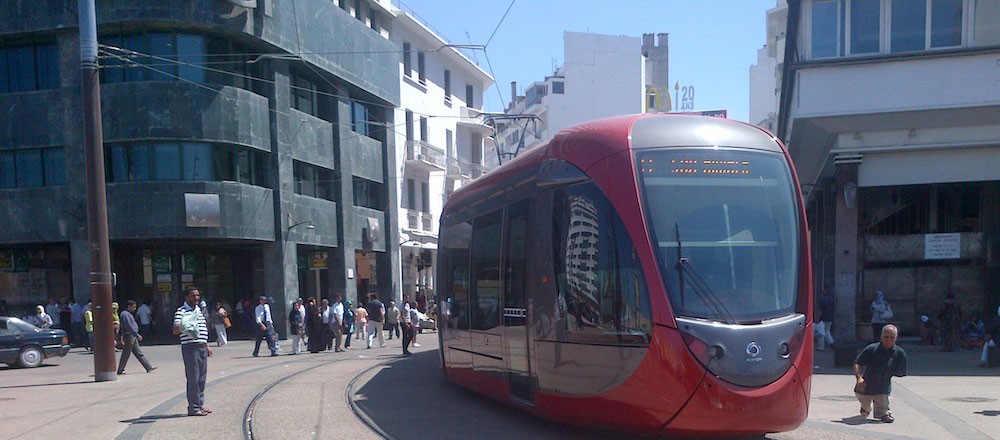
A tramway’s transformative influence
Jeune Afrique, a weekly magazine that covers current affairs and politics across Africa, has published an excellent article chronicling the success of Casablanca’s tramway system. The trams have been rolling for less than a year, but they’re already absorbed into the city’s daily life.
As Waterloo Region prepares for ION (and as other Ontario municipalities march toward some kind of mass transit), I thought I’d translate a few excerpts from the Jeune Afrique article that illustrate the tangible impact Casablanca’s tramway has had for its citizens.
More than just a transportation solution, the tramway has brought benefits for heritage preservation, economic development, public safety, and pedestrianisation. Some of the evidence is certainly anecdotal, but cities in earlier stages of the planning process can definitely learn — or, at the very least, gain some courage — from Casablanca’s experience.
Take, for example, the attidudes of Casablancans as the tramway was being built — it’ll never get done on time, it costs too much, construction is causing traffic headaches, we don’t want this — opposition which quickly dissipated as soon as the trains actually started running. In fact, a second tramway line is already in the works.
Without further ado, here’s my translation of the article’s most salient points:
Sam NabiFor four long years of construction, Casablancans cursed this tramway that was supposed to revolutionise transportation, but seemed to bring only dust, traffic snarls, and parking headaches. Although opposition to the project never reached the fever pitch of the Stop TGV movement (which railed against a high-speed train from Tangier to Rabat), it was still viewed with deep scepticism. […] Even as late as June 2012, most citizens thought that it would never be finished on time. Despite this pessimism, the project was completed on schedule and an inauguration ceremony was held as planned on the symbolic date of 12/12/12 by King Mohammed VI.
[…]
Less than a week after the tramway’s inauguration, it confronted its first big test: the biannual football derby between bitter rivals Wydad and Raja. Marred by violence in the past, would this match sully the reputation of Casablanca’s new tramway system as a clean, quiet, and civilised mode of transport? Would the hordes of hooligans descending upon downtown Casablanca make quick work of the brand new trains?
As if by miracle, the tramway functioned normally that day. “Nothing happened,” remembers Réda, a sports journalist. Surveillance cameras in the trams and on the platforms, as well as police officers patrolling the stations, proved to be enough to maintain peace and order on the tramway during the football derby.
[…]
In reality, the tramway is already part of the scenery. The long period of construction included road realignments, over 200 kilometres of reconstructed sidewalks, and the installation of new signalisation infrastructure – and Casablancans are now comfortable and familiar with the tramway. In some places, the change is spectacular. One part of Mohammed V Boulevard has been completely pedestrianised. In fact, an old tramway circulated along this same artery until the 1950s. Building facades, some in Art Deco style, have been revitalised. The tramway has spurred property owners to take ownership of the city’s architectural heritage, which had been threatened by decades of neglect.
[…]
The 31-kilometre tramway line, stretching from the Sidi Moumen neighbourhood to the beach at Ain Diab, reunites urban neighbourhoods that had been segregated by the city’s erratic street network. This summer, beachgoers took to the tramway en masse, tolerating the long, winding route for the comfort of an air-conditioned train.
[…]
Even if it hasn’t yet replaced other modes of transport, the tramway is the best choice for travelling along certain routes which have traditionally been very congested. To get to the Derb Ghallef market, the city’s hub for buying and selling electronics, the tramway is unbeatable. Same goes for Hassan II Avenue, which houses the city’s financial district. For students seeking an affordable commute, it’s also the best way to get to the universities in the South end of town.
[…]
Perhaps the most striking transformation that the tramway has brought about is in Sidi Moumen – once known as the neighbourhood that raised the terrorists who carried out the 2003 bombings, it is now home to the tramway’s maintenance facility, which employs 1,200 people.

Comments
Interesting accessibility benefits for a variety of people!
Post a comment